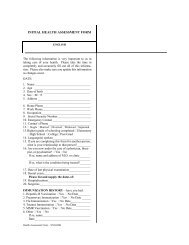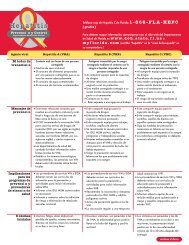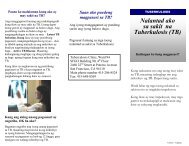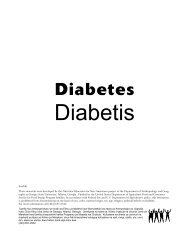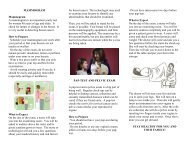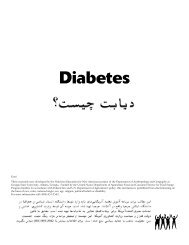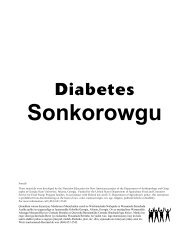Create successful ePaper yourself
Turn your PDF publications into a flip-book with our unique Google optimized e-Paper software.
<strong>Diabetes</strong><br />
<strong>Urdu</strong><br />
These materials were developed by the Nutrition Education for New Americans project of the Department of Anthropology and Geography<br />
at Georgia State University, Atlanta, Georgia. Funded by the United States Department of Agriculture Food and Consumer<br />
Service for Food Stamp Program families. In accordance with Federal law and U.S. Department of Agriculture's policy, this institution<br />
is prohibited from discriminating on the basis of race, color, national origin, sex, age, religion, political beliefs or disability.<br />
For more information call (404) 651-2542.
<strong>Diabetes</strong><br />
What is diabetes? <strong>Diabetes</strong> is a disease in which the body does not<br />
produce or properly use insulin.<br />
Insulin is a hormone that changes sugar, starches and other food into energy<br />
needed for daily life.<br />
How is diabetes managed?<br />
The management of diabetes has three parts:<br />
The management of diabetes has three parts:<br />
♦ Healthy Eating<br />
Healthy Eating<br />
♦ Physical Activity<br />
Physical Activity<br />
♦ Medication (if needed)<br />
Medication (if needed)<br />
How can I control my diabetes? You can help control your blood sugar (also called<br />
blood glucose) and diabetes when you eat healthy, get enough physical activity, and stay at a<br />
healthy weight.<br />
A healthy weight also helps you control your blood fats (cholesterol) and lower your blood<br />
pressure.<br />
Many people with diabetes also need to take medicine to help control their blood sugar.
Eat Healthy<br />
Using the Food Guide Pyramid helps you eat a variety of healthy<br />
foods. Variety means eating foods from each of the food groups<br />
every day. When you eat different foods each day, you get the<br />
vitamins and minerals you need.<br />
Here is an example of getting a variety of foods each day.<br />
Day 1 Day 2<br />
Grains: tortilla brown rice<br />
Fruit: apple mango<br />
Vegetable: broccoli tomatoes<br />
Dairy: milk yogurt<br />
Protein: chicken beans
Eat From all the Food Groups<br />
♦ Buy whole grain breads and cereals. Some examples are<br />
whole grain breads, bran flakes, brown rice, wholewheat<br />
pasta, bulgur and amaranth.<br />
♦ Eat fewer fried and high-fat starches such as pastries,<br />
biscuits or muffins.<br />
♦ Fresh fruit is the best choice. When<br />
buying canned fruit, look for the words,<br />
“canned in its own juice.”<br />
♦ Buy smaller pieces of fruit, and drink fruit juices in small<br />
amounts.<br />
♦ Eat raw and cooked vegetables with very little fat.<br />
♦ Use mustard instead of mayonnaise on a sandwich.<br />
♦ Use vegetable cooking oil spray instead of oil, shortening, butter or<br />
margarine, or lard when<br />
cooking.<br />
♦ Cooking techniques that are good for you are: baking, broiling, boiling, stir-frying,<br />
roasting, steaming, stews and<br />
grilling. Avoid cooking foods<br />
in large amounts of oil.<br />
♦ Choose lower fat cuts of meat<br />
such as: chicken, turkey. When<br />
buying pork, beef and ham, trim off the extra fat.<br />
♦ Choose fat free (skim) or low-fat (1%) milk,<br />
or dairy foods.
Grains, Beans and Starchy<br />
Vegetables<br />
What are starches or carbohydrates?<br />
Starches are breads, grains, cereal, pasta, beans or starchy<br />
vegetables. Eat some starches/carbohydrates at each meal.<br />
People might tell you not to eat many starches/carbohydrates,<br />
but that is no longer correct advice. Eating starches/<br />
carbohydrates is healthy for everyone, including people with diabetes.<br />
How many starches/carbohydrates do I need<br />
each day? 6–11 servings each day<br />
The number of servings you should eat each day depends on:<br />
♦ The calories you need<br />
♦ Your diabetes plan<br />
What do starches and carbohydrates do for my body? Starches give your body<br />
energy, B vitamins, minerals and fiber. Whole grains are healthier because they have more<br />
vitamins, minerals, and fiber. Fiber helps you have regular bowel movements. They also help you<br />
better control your blood sugar.
Grains, Beans and Starchy Vegetables (continued)<br />
How much is one serving of starch/carbohydrate?<br />
♦ 1 slice of bread<br />
♦ 1 small potato, casaba or plantain<br />
♦ ½ cup cooked cereal such as oatmeal or cream of wheat<br />
♦ ¾ cup dry cereal such as corn flakes<br />
♦ a cup of cooked rice<br />
♦ 1 small tortilla, roti bread or enjira bread<br />
You may need to eat one, two or three starch/carbohydrate servings at a meal. If you need to eat<br />
more than one serving at a meal, choose different foods from this food group. For example:<br />
Breakfast: ¾ cup dry cereal and 1 slice of bread—2 servings<br />
Lunch: a cup of rice and ½ cup of cooked plantains—2 servings<br />
Dinner: ½ cup of pasta and one bread stick—2 servings<br />
Snack: 6 crackers—1 serving<br />
Total for the day: 7 servings. Notice that the carbohydrates are balanced at the meals. This can<br />
help you control your blood sugars.
Vegetables<br />
Vegetables are healthy for everyone, including people with<br />
diabetes. Eat raw and cooked vegetables everyday. Vegetables<br />
give you vitamins, minerals, and fiber with very few calories. Look for vegetables that are bright in<br />
color. A few examples are: carrots, peppers, eggplant, broccoli, tomatoes, and spinach.<br />
You should have 3 to 5 servings every day.<br />
How much is a serving of vegetables?<br />
♦ ½ cup cooked vegetables, like cooked green beans,<br />
eggplant, spinach and squash<br />
♦ 1 cup raw vegetables, like a salad, carrot sticks or cut<br />
up cucumbers<br />
♦ ½ cup vegetable juice, like tomato juice or carrot<br />
juice<br />
You might need to eat one, two or three vegetable servings at a meal. If you need to eat more than<br />
one serving at a meal, choose different types of vegetables or have two or three servings of one<br />
vegetable.
Fruits<br />
Fruit is healthy for everyone, including people with diabetes. Fruit gives<br />
you energy, vitamins and minerals and fiber.<br />
How many servings of fruit do I need? 2 to 4 servings<br />
What is a serving of fruit?<br />
♦ 1 small apple or pear (approximately the size of a woman’s<br />
fist)<br />
♦ ½ cup of apple or orange juice<br />
♦ ½ of a grapefruit<br />
♦ 1 small banana or ½ of a large banana<br />
♦ ½ cup of chopped fruit<br />
♦ ¼ cup of raisins or dried fruit (approximately what would<br />
fit in the palm of your hand)<br />
You might need to eat one or two servings of fruit at a meal.<br />
How should I eat fruit?<br />
♦ Eat fruits raw, or as juice with no sugar added.<br />
♦ Buy smaller pieces of fruit.
Milk and Yogurt Foods<br />
Fat-free and low-fat milk and yogurt are healthy for everyone,<br />
including people with diabetes. Milk and yogurt give you<br />
energy, protein, calcium, vitamin A, and other vitamins and<br />
minerals.<br />
Drink fat-free (skim or nonfat) or low-fat (1%) milk each day.<br />
Eat low-fat or fat-free yogurt. They have less total fat,<br />
saturated fat and cholesterol.<br />
How many servings do I need each day? 2 to 3 servings each day. Note: If you are<br />
pregnant or breastfeeding, eat four to five servings of milk and yogurt each day.<br />
How much is a serving of milk and yogurt?<br />
♦ 1 cup fat-free plain yogurt (look for yogurts flavored with aspartame also)<br />
♦ 1 cup skim or low-fat milk<br />
Note: Avoid yogurts that say, “fruit on the bottom”. They contain high amounts of added sugar.
Meat, Poultry, Fish, Eggs<br />
and Nuts<br />
This food group contains meat (beef, pork,<br />
lamb), chicken, turkey, eggs, fish, nuts and<br />
tofu or soy products. Eat small amounts of<br />
some of these foods each day. All these foods<br />
provide our bodies with protein.<br />
Protein foods help your body build tissue and muscles. They also give your body vitamins and<br />
minerals.<br />
How many protein foods do I need each day? 2 to 3 servings<br />
How much is a serving of meat, poultry, fish, eggs<br />
and nuts?<br />
♦ 2 to 3 ounces of cooked fish<br />
♦ 2 to 3 ounces cooked chicken<br />
♦ 3 to 4 ounces tofu (½ cup)<br />
♦ 1 egg (equals one ounce of protein)<br />
♦ 1 slice of cheese or one ounce of cheese (approximately<br />
the size of a D battery)<br />
♦ 2 tablespoons of peanut butter (equals one ounce)<br />
Helpful Tips:<br />
♦ The serving size you eat now may be too<br />
big.<br />
♦ Take a look at a deck of cards. This size<br />
is equal to 2 to 3 ounces.<br />
♦ Buy cuts of beef, pork, ham and lamb<br />
that have only a little fat on them. Trim<br />
off the extra fat.<br />
♦ Eat chicken or turkey without the skin.<br />
♦ Cook protein foods in low fat ways:<br />
broil, grill, stir-fry, roast, steam, boil or<br />
stew.<br />
♦ Use only small amounts of oil when cooking meats, or using a cooking spray instead of<br />
oil.<br />
♦ Have a meal without meat. Try beans or tofu as your protein source.
Fats, Oils and Sweets<br />
Fats and oils include butter, margarine, lard and oils that we add to<br />
foods and use to cook foods. Some oils are canola, olive and<br />
vegetable. Fats are also found in meats, dairy products, snack foods<br />
and some sweets. To control your diabetes, it is best to eat foods with less fat and less saturated<br />
fat (fat we get from meat and animal products).<br />
Sweets are sugary foods that have calories but not very many vitamins and minerals. Some sweets<br />
are also high in fat—like cakes, pies, and cookies.<br />
Eating too many sugary and high fat foods makes it hard to control your blood sugar and weight. If you do<br />
eat fats and sweets, eat small portions.<br />
How much is a serving of fats, oils and sweets?<br />
♦ 1 teaspoon oil<br />
♦ 1 tablespoon regular salad dressing<br />
♦ 2 teaspoons light mayonnaise<br />
♦ 1 strip of bacon<br />
♦ 1 cookie<br />
♦ 1 plain doughnut<br />
♦ 1 tablespoon syrup<br />
♦ 10–15 chips
<strong>Urdu</strong><br />
These materials were developed by the Nutrition Education for New Americans project of the Department of Anthropology and Geography<br />
at Georgia State University, Atlanta, Georgia. Funded by the United States Department of Agriculture Food and Consumer<br />
Service for Food Stamp Program families. In accordance with Federal law and U.S. Department of Agriculture's policy, this institution<br />
is prohibited from discriminating on the basis of race, color, national origin, sex, age, religion, political beliefs or disability.<br />
For more information call (404) 651-2542.



